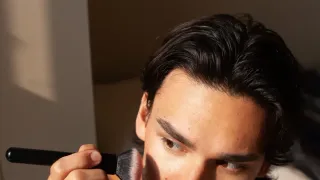
4 hours ago
Tattooed, Tender, and Totally Queer: How Ink Tells the Stories of LGBTQ+ Bodies
READ TIME: 4 MIN.
For LGBTQ+ people, the body has often been a site of struggle, visibility, and transformation. Tattoos—once dismissed as marks of deviance—have become a powerful medium for queer people to reclaim their bodies and histories, inscribing identities in ink that are as nuanced and vibrant as the community itself. These markings are not just art; they are autobiography, protest, and connection, each line and symbol a chapter in the ongoing narrative of queer life.
The use of tattoos as a tool for queer storytelling is rooted in both ancient history and modern resistance. Sapphic symbols such as violets, inspired by the poetry of Sappho of Lesbos, have long expressed love between women, their delicate petals appearing in both poems and contemporary ink as a quiet but potent signal of sapphic identity. Other symbols, like the interlocking double Venus, emerged in the 20th century as a visible emblem of lesbian love, finding their way onto skin as tattoos, jewelry, and protest banners.
Tattooing has often carried the weight of rebellion and marginality, especially for those whose bodies have been policed, pathologized, or erased. In the late 19th and early 20th centuries, queer men in Europe used tattoos as a covert code, signaling desire and community in societies that criminalized homosexuality. Medical case studies and police records from this era reveal how tattoos—sometimes placed in intimate or hidden locations—became discreet signifiers of sexual orientation, connection, and resistance.
These tattoos were not always overtly erotic; symbols like clasped hands, daggers, or snakes could indicate a belonging to queer circles, functioning as a form of visual language understood only by those in the know. In environments where queerness was surveilled and punished, the act of tattooing became an act of both personal agency and collective defiance.
Women and nonbinary people have also used tattoos to subvert norms and signal their identities. During the 1940s, for example, lesbians in the United States adopted the nautical star tattoo, often placed on the inner wrist, as a subtle advertisement of their sexuality—a coded signal at a time when overt expression could be dangerous.
Some of the most enduring symbols in queer tattoo culture have their origins in trauma and persecution. The pink triangle, first used by the Nazis to mark and persecute homosexual men in concentration camps, has been reclaimed by generations of LGBTQ+ people as a badge of pride and resistance. Today, an upside-down pink triangle tattoo is a common sight among queer people, a deliberate act of remembrance and defiance that transforms a symbol of victimization into one of empowerment.
Similarly, the black triangle—used by the Nazis to mark “asocial” women, including lesbians and others who did not conform to social norms—has been reclaimed as a symbol of lesbian strength and survival. The act of tattooing these symbols is not only a personal expression but also a political act, declaring “I am here, I survived, I am proud.”
Modern queer tattoo culture is rich with symbols both old and new. Rainbows, the most globally recognized sign of LGBTQ+ pride, are joined by lavender rhinoceroses, carabiners, and even playful references to “scissoring”—each marking the body as both a canvas and a manifesto.
Tattooing is deeply communal in queer spaces. For many LGBTQ+ people, especially those estranged from their families of origin, the tattoo studio is a place of affirmation, chosen kinship, and safety. Queer tattoo artists and clients often build networks of mutual support, sharing stories and survival strategies as ink is laid down. The process itself can be tender, intimate, and transformative—a rite of passage and a celebration of self.
This communal aspect is not new. In the 20th century, queer men from working-class backgrounds—soldiers, sailors, laborers—used tattoos to create community and kinship, especially in environments where queerness was otherwise invisible or stigmatized. The act of being tattooed, sometimes by a queer artist, provided a context for connection and intimacy, forging bonds that transcended social boundaries.
Today’s queer tattoo spaces are often explicitly inclusive, with artists specializing in affirming tattoos for transgender people—covering scars, celebrating gender euphoria, or marking milestones of transition. Such tattoos can be acts of healing, affirmation, and visibility, offering a form of bodily autonomy that is both deeply personal and powerfully political.
Tattoos on queer bodies are more than skin deep—they are a living, breathing archive of LGBTQ+ resilience. As symbols are inked, reclaimed, and reinvented, they record personal journeys and collective histories that might otherwise be lost. In a world where queer stories have so often been erased, criminalized, or pathologized, the tattoo is both evidence and artistry, a testament to lives lived boldly and authentically.
In the words of one interviewee for Honi Soit, tattoos are “a physical representation of otherness,” but also of connection—a way to find one another in a sometimes hostile world. Whether subtle or flamboyant, historical or newly invented, each tattoo is a declaration: I am here, and my story matters.






